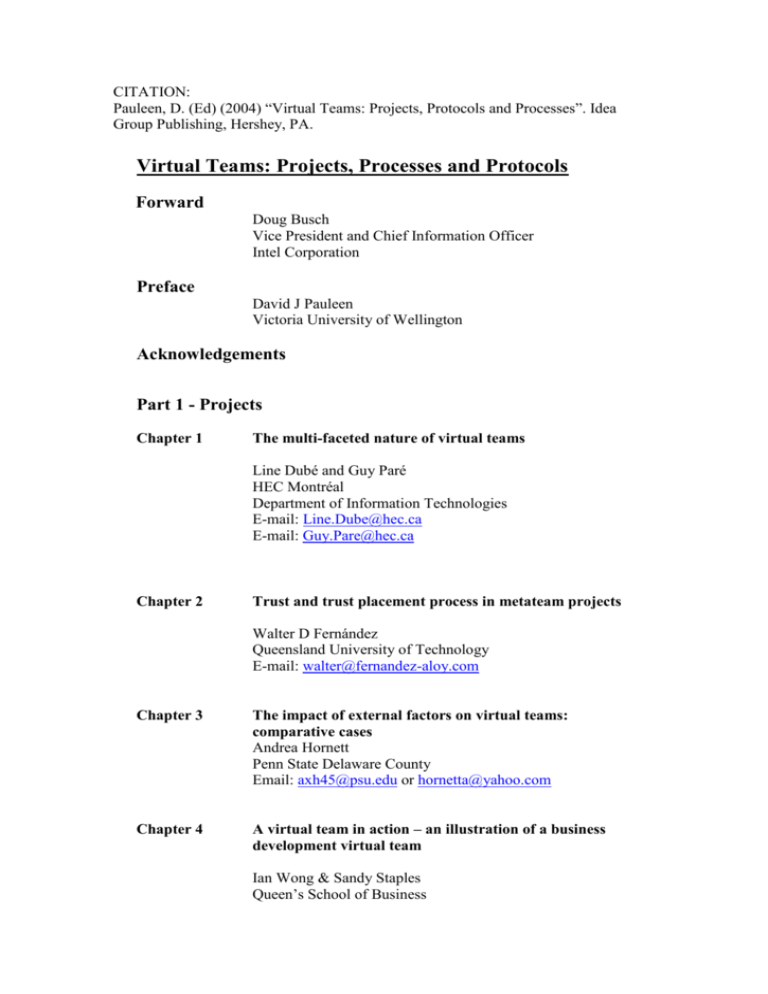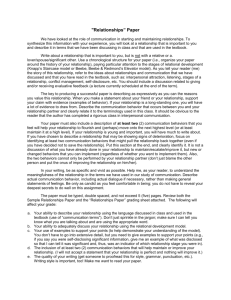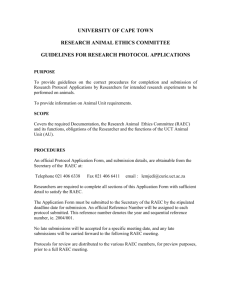Virtual Teams: Projects, Processes and Protocols
advertisement

CITATION: Pauleen, D. (Ed) (2004) “Virtual Teams: Projects, Protocols and Processes”. Idea Group Publishing, Hershey, PA. Virtual Teams: Projects, Processes and Protocols Forward Doug Busch Vice President and Chief Information Officer Intel Corporation Preface David J Pauleen Victoria University of Wellington Acknowledgements Part 1 - Projects Chapter 1 The multi-faceted nature of virtual teams Line Dubé and Guy Paré HEC Montréal Department of Information Technologies E-mail: Line.Dube@hec.ca E-mail: Guy.Pare@hec.ca Chapter 2 Trust and trust placement process in metateam projects Walter D Fernández Queensland University of Technology E-mail: walter@fernandez-aloy.com Chapter 3 The impact of external factors on virtual teams: comparative cases Andrea Hornett Penn State Delaware County Email: axh45@psu.edu or hornetta@yahoo.com Chapter 4 A virtual team in action – an illustration of a business development virtual team Ian Wong & Sandy Staples Queen’s School of Business Queen’s University E-mail: sstaples@business.queensu.ca Part 2 – Protocols Chapter 5 Long distance leadership: communicative strategies for leading virtual teams Stacey L. Connaughton Department of Communication Rutgers University staceyc@scils.rutgers.edu John A. Daly Department of Communication The University of Texas at Austin daly@mail.utexas.edu Chapter 6 Towards integration of artifacts, resources, and processes for distributed virtual teams Schahram Dustdar Information Systems Institute, Distributed Systems Group Vienna University of Technology dustdar@infosys.tuwien.ac.at Chapter 7 Best practices for virtual team effectiveness Sandy Staples, Ian Wong and Ann Frances Cameron Queen’s School of Business Queen’s University E-mail: sstaples@business.queensu.ca Chapter 8 Varieties of virtual organizing and their knowledge sharing strategies Andrea Hornett Penn State Delaware County Email: axh45@psu.edu or hornetta@yahoo.com Part 3 - Processes Chapter 9 Working closer Tammie D. Hertel Simcon Corporation Chapter 10 Prelude to virtual groups: leadership roles and technology variety within investment clubs Terri L. Griffith Leavey School of Business Santa Clara University tgriffith@scu.edu Dave Meader Management Information Systems Eller College of Business and Public Administration dmeader@eller.arizona.edu Chapter 11 Mediating complexity: facilitating relationship building across boundaries in start-up virtual teams David J. Pauleen and Lalita Rajasingham School of Information Management Victoria University of Wellington Chapter 12 Trust, rationality and the virtual team Peter Murphy Master of Communications Program School of Information Management Victoria University of Wellington Virtual Teams: Projects, Protocols and Processes Foreword The seventeenth century philosopher Thomas Hobbes described life in the state of nature as “nasty, brutish, and short”. The quality of life has improved for most of us since Hobbes made his famous assertion, but our work lives still often seem frantic, frustrating, and confusing. In large organizations, very few goals can be reached solely through individual effort. The complexity of large organizations also prevents most individuals from working within a single, stable team. Our work leads each of us to be a member of multiple interlocking teams, focused on different, but related goals. We seem at times to be caught in a web of organizational structure. Many organizations have adopted the concept of a “Virtual Team” to help deal with these challenges. The term usually refers to collections of individuals, brought together from different departments or organizations, to focus on a specific objective. The Virtual Team is not the organizational ‘home’ for the participants- it is a structure they use to accomplish part of their job. Some of these teams have long lives, existing for many years. Others may arise in response to a specific problem and dissolve quickly. Virtual Teams include individuals who know each other well (for better or worse), and individuals who are strangers. Many teams are contained within a single company or organization, but increasingly our goals span the boundaries of enterprises, with suppliers, customers and partners working closely together. As large organizations have become more geographically distributed, the need to work in distributed Virtual Teams has become commonplace. We often collaborate with team members located at another campus, in another city or country, or on another continent. Some of these team members we seldom (or never) meet in person. Along with the barrier of distance comes the barrier of time; there may be no single time of day, which fits into the normal working hours of all team members. I have always found the term “Virtual Team” to be a misnomer. In spite of their often transitory nature, they are real teams. They face all the challenges of classic team evolution and in fact often face more difficult problems, because they lack the reward and authority structures that shape conventional teams. The goals set for Virtual Teams are often very critical: responding to a crisis in the business; solving a particularly difficult problem; bringing a highly visible project to completion. Successful use of Virtual Teams requires team members with appropriate skills and behaviours, team leaders who know how to quickly assemble an effective team and manage the evolving dynamics in the group, and an organizational culture that provides the right context for the team to succeed. Lacking any one of these factors, a Virtual Team can easily flounder. I recently heard a respected organizational development consultant cite research showing that it takes 5 to 7 years to really trust a colleague. The research may well reflect a fundamental aspect of human nature, but it also is completely inconsistent with the realities of business in today’s world. We need leadership approaches which develop an effectively Virtual Team in days or weeks, not months or years. This book is an important resource for improving the use of Virtual Teams. The case studies and research results presented give us new insights into the real behaviour of Virtual Teams, facing real challenges. Our organizations can only benefit from this deeper understanding, as we use Virtual Teams to solve real problems. Doug Busch Vice President and Chief Information Officer Intel Corporation PREFACE David J. Pauleen ‘Virtual teams’ is one of the many hot topics in business these days. But unlike a fad, virtual teams appear to have staying power. Their use in organizations is growing in concert with globalization, the rise of the knowledge worker, the need for innovation, and the increasing use of information and communication technology (ICT). While the use of virtual teams continues to grow, our understanding of how their many unique characteristics work (or don’t work) together lags far behind (Cramton & Webber, 2000). Both researchers and practitioners are trying hard to correct this situation, and in this book their best efforts are brought together. In the thirteen chapters presented here, the authors offer a well-rounded picture of the current state of virtual team practice and research; that is, what is working and what’ is still problematic. In addition, the chapters contain invaluable advice on how to manage the conditions that will facilitate the most effective virtual teams. Virtual team members, leaders, managers, senior executives in IT, HR and other functional areas as well researchers - can all gain from a careful reading of this book. The current notion of virtual teams has been around since the mid-1990’s. First addressed by the practitioner literature (Grenier & Metes, 1995; Lipnack & Stamps, 1997; O’Hara-Devereaux & Johansen, 1994), and then by researchers investigating primarily student populations (Jarvenpaa, Knoll & Leidner, 1998; Sahay, Sarker & Lau, 1999; Warkenten & Beranek, 1999), research on virtual teams in organizations has only emerged in the last few years. As the reader will soon see, researchers are grappling with everything from defining what makes a virtual team virtual to all the various team, communication and project processes and protocols that might influence how well a team works together and accomplishes its tasks, as well as the influence of organizational policies, technology, and boundary crossing on virtual team dynamics and effectiveness. One could make the case that different forms of the virtual team have been around since the beginning of trade, with the representatives of manufacturers, agents, traders and buyers exchanging goods and credit over distance using sophisticated protocols and available technology (Murphy touches upon this notion in Chapter 13). These days, organizations and management are pretty much using virtual teams by default. Global and economic pressures have forced new organizations into new competitive strategies. Almost simultaneously various information and communication technologies (ICT) were being developed (Coleman, 1997). These developments led to the use of virtual teams (Moshowitz, 1997). For the most part these teams are thrown together, in an ad hoc fashion, often without a clear idea of how they might function effectively or how the surrounding organizations can effectively support them (Vickery, Clark, & Carlson, 1999). Meanwhile, the virtual team leaders and team members are in the thick of it, operating ‘from the seat of their pants’ often without the virtual communication and team skills required for the virtual environment and without organizational support and often working at odds with organizational policies that are really appropriate only for traditional organizations (Vickery et al., 1999). Significant organizational, technological, personal and cultural barriers to the implementation of virtual teams exist (Grenier and Metes, 1995) and must be understood before organizations can make the best use of virtual teams. This book addresses many of these issues in a practical way, supported by organizational-based research. The reader of these articles will gain a wide-ranging view of how virtual teams work (or don’t) within organizations, how members and leaders of such teams are coping (or not), and how the situation can be improved at the organizational, team, and employee level. The Structure of the Book The book is divided into three sections, Projects, Protocols and Processes. However as the reader will soon see, nothing about virtual teams is so clear-cut. The issues raised in these projects, protocols and processes sections are all closely linked together, and hence each of the chapters addresses at least two and often three of these areas. Part 1: Projects The first section of the book attempts to give the reader a concrete conceptualisation of what virtual teams are and how they function in the ‘real’ world of organizations. Most of the chapters in this section describe project teams and some of the key issues associated with working virtually in such project environments. These include issues such as trust and the impact of various organizational factors on virtual team project performance. Suggestions are made for improving virtual team performance. Part 2 Protocols The second part expands on the first section by looking at more specific ways that virtual team members, leaders and managers can approach important virtual team concerns. The reader will find a wide range of research-based discussion of virtual team issues, such as leadership, technology, and knowledge sharing. Specific protocols for constructive responses to these issues are proposed. Part 3 Processes The third section investigates virtual team processes involving leadership, organizational and employee dynamics. These chapters will help the reader to gain a greater understanding of such processes with suggestions on how those involved can effectively manage them. The last chapter is a ‘thought’ piece on the nature of virtual trust that may well challenge organizational leaders and managers basic assumptions of what it takes to successfully make the transition to virtual work. Chapter Summaries Chapter One, ‘The multi-faceted nature of virtual teams’, serves as an excellent introduction to virtual teams. Based on an extensive review of the literature and a series of in-depth interviews with over forty experienced virtual team members and leaders, the authors identify the key characteristics of virtual teamwork as well as those characteristics that distinguish various virtual team configurations. They suggest that researchers must now adopt a multi-dimensional view of virtual teams – a view that recognizes the diversity of possible virtual team arrangements - in order to adequately compare empirical findings, build a cumulative tradition in this field of research, and provide practitioners with a framework to help them manage virtual teams effectively. Chapter 2, ‘Trust and trust placement process in metateam projects’, takes an in-depth look at a virtual meta-team project. A metateam is a temporary group composed of two or more geographically and inter-organizationally dispersed teams, commercially linked by project-specific agreements and enabled by electronic means of communication. Metateams have been largely unexplored in the IS literature, but they are economically important to major corporations and their IT vendors as they promise to build IT solutions of high complexity, by integrating expertise from different fields and different organisations and by conquering barriers of time and space. In a global business environment that demands innovation, flexibility, and responsiveness, metateams represent a revolution in the way organisations and practitioners do IT projects. However, as the chapter discusses, managing metateams presents unique difficulties due to conflicting demands arising from multiple realities and the way in which effectiveness of the trust placement process significantly affects project success. In chapter 3, ‘The impact of external factors on virtual teams: comparative cases’, it is suggested that while virtual teams are powerful organizing mechanisms, practitioners and researchers need to pay attention to how corporate organizing structures both impact and are impacted by virtual work environments. This chapter reports on two cases where dynamics outside the virtual project teams powerfully affected the teams. These cases, both based on studies of real project teams operating inside corporations, highlight the desirability of understanding virtual teams in context. While external factors are not unique to teamwork, their role has not been explored in depth in research on virtual teams. Dynamic forces outside teams seem more difficult to anticipate and identify when team members are working virtually. These powerful but invisible dynamics can be frustrating to virtual team leaders and members. This chapter concludes that, contrary to initial expectations, virtual teams are not replacing traditional forms of organizing. They are co-existing with traditional forms and dynamics such as business drivers, hierarchies, departments, strategic priorities, and business needs. This co-existence can be fraught with conflict. The final chapter of the first section takes an in-depth look at a virtual team in action. It describes the characteristics of a project-based virtual team. Although there is some empirical research on virtual teams, little research has focused on describing the practical application of a virtual team in the organizational environment. This chapter describes the task and goals of the team, how it handled virtual challenges and used information technology to bridge distance, and how it functioned within its organization. Specifically the task of the team, team composition, team beliefs, team processes (e.g. coordination, communications, and sharing of information), organizational context, and the effectiveness of the team are described. The chapter concludes with a summary of characteristics of successful virtual teams. Part 2 begins with the book’s first chapter on virtual leadership. ‘Long distance leadership: communicative strategies for leading virtual teams’ draws on data from a series of in-depth interviews with project leaders, senior managers, and executives of six global organizations and illustrates what virtual team leaders perceive to be effective communicative tactics in virtual settings. Specifically, it explores tactics related to two leadership challenges commonly cited in the academic and popular press: 1) overcoming virtual team members’ feelings of isolation—feelings of disconnectedness, lack of cohesiveness, and limited identification with the virtual team leader and/or the organization; and, 2) building and maintaining trust. The chapter also presents some strategies for managing cross-cultural communication issues and offers tips on the use of communication technologies in distanced settings. In the last decade, business processes have changed across various dimensions (e.g. flexibility, interconnectivity, coordination style, autonomy) due to market conditions, organizational models, and the usage scenarios of information systems. Virtual teams are under heavy pressure to increase time-to-market of their products and services, and lower their coordination costs. Chapter 6, argues that a fundamental need for distributed virtual teamwork is to have access to contextual information, i.e. to see a “knowledge trail” of who did what, when, how, and why. This chapter discusses underlying conceptual issues and presents in some detail one particular implemented information system (Caramba) that supports the integration of artifacts, resources, and business processes for virtual teams. Chapter 7, ‘Best practices for virtual team effectiveness’ argues that although working in geographically-distributed teams is becoming more widespread in organizations today, how to do so effectively is not yet fully understood. The purpose of this chapter is to improve the understanding of what makes virtual teams effective. This is done by identifying the best practices that members of virtual teams should follow, the best practices for leaders and sponsors of virtual teams, and the best practices for the organizations that the virtual teams are a part of. Best practices in these categories are drawn from three major sources: (1) empirical evidence from case studies of six existing virtual teams; (2) the business press and academic literature related to virtual teams; and, (3) traditional team (i.e. collocated) literature and telecommuting literature (i.e. research on virtual work at the individual level). The chapter concludes with implications for organizations and potential research directions. Chapter 8, ‘Varieties of virtual organizations and their knowledge sharing systems’ provides analysis of the differences between virtual teams and communities of practice, and links two growing phenomena: virtual organizing and knowledge sharing (knowledge management), based on empirical work from both fields of research. By integrating various types of virtual organizing with corresponding knowledge sharing systems, this chapter provides a framework that virtual team leaders, members and consultants can use to improve management of virtual endeavors. This chapter suggests that calling nearly everything a “community of practice” creates unrealistic expectations for spontaneous organizing and knowledge sharing. Indeed, the managers of virtual project teams have organizing challenges that are very different from stewardship of communities of practice. Practitioners who are struggling with “onesize-fits-all” prescriptions for virtual work or knowledge management can use this chapter’s three generalized types to develop communications and management strategies appropriate for the unique cultures found in each of the various combinations of virtual organizing and knowledge sharing. Part 3 begins with ‘Working closer’ which takes a compelling look at how employees are responding to the organizational use of virtual teams. As the author points out, it is likely that employees will work on a virtual team at some point in their careers. However, the chapter’s findings question how effectively organizations, training, and technology support the needs of virtual teams and urge that organizations communicate what collaborative and knowledge sharing behaviors are expected, establish reward and recognition systems that reinforce those behaviors, ensure employees have the skills and tools required to fulfil those expectations, and develop managers that role model and reinforce the desired behaviors. The chapter also considers the function of technology in virtual teams and concludes that collaborative technologies must also become more self-managing, provide more compelling asynchronous capabilities, and cater to individuals who may simultaneously be part of many teams. In Chapter 10, ‘Prelude to virtual groups: leadership and technology in semivirtual groups’, a study of 76 more and less virtual investment clubs examines the relationships between communication technologies used for club business (from face-to-face to more highly technologically enabled media), group leadership role behaviors, and club portfolio value. The results are very interesting with more and less virtual clubs benefiting from different forms of leadership behaviors. Clubs using fewer technologies seem to benefit from a greater focus on socioemotional role (communication) behaviors, while the opposite is found in clubs using more technologies. The effect for procedural role behaviors (agenda setting and the like) appears to run in the opposite direction: clubs using more technologies seem to benefit from a greater focus on procedural role behaviors, while the opposite is found in clubs using fewer technologies. Practitioners will need to take into account both the obvious and subtle differences between groups with more and less virtual characteristics. Chapter 11 is also on the theme of leadership It provides findings that the reader can compare and contrast with those of the proceeding chapter and Chapter 5. ‘Mediating complexity: facilitating relationship building across boundaries in start-up virtual teams’ reports on part of a field study of New Zealand-based virtual team leaders working with boundary spanning virtual teams. The chapter looks at boundarycrossing issues (organizational, cultural, language, time and distance) from a team leaders’ perspective, and reports on the significant way crossing boundaries can affect relationship building. It then discusses ways that virtual team leaders and organizations can improve team leaders’ and members’ virtual skills in mediating communication across boundaries with available ICT. Finally, the last chapter, ‘Trust, rationality and the virtual team’ takes an indepth look at the issue of trust in virtual teams. Virtual teams need trust in order to function, as it is an efficient way of gaining group cooperation. As the author explains, online, trust is more effective than instruction or authority or status in getting people who are largely strangers to one another to work together. However, trust is not a simple quality. The kind of trust that is the cement of distance relations of a global or virtual kind is different both from the type of trust that binds face-to-face interactions and from the procedural kind of trust that operates in regional or national organizations of a traditional managerial kind. This chapter looks at the ways in which trust between virtual team members is generated, and theorizes that “trust between strangers” is optimally generated when persons are allowed to self-organize complex orders and create objects and processes of high quality. The chapter also looks at the kinds of personalities that are best suited to working in a virtual collaborative environment and concludes that persons who prefer strong social or procedural environments will be less effective in a virtual environment. In contrast, selfsteering (“stoic”) personality types have characteristics that are optimally suited to virtual collaboration. As the reader will now be aware, although virtual teams are assuming a greater role in the life of organizations and employees, many critical issues and processes remain under-researched and even undiscovered, presenting practitioners and researchers with unexpected difficulties and challenges. Those working in and with virtual teams are trying to navigate new and uncharted terrain without maps and little in the way of guidance. This book’s broad-ranging discussion of key virtual team protocols and processes presented in real organizational contexts should help light the way for both practitioners and researchers, hopefully ensuring a smoother trip and a more effective use of virtual teams. References Coleman, D. (1997). Groupware: collaborative strategies for corporate LANS and intranets. Upper Saddle River, Prentice Hall. Cramton, C., & Webber, S. (2000), Attribution in distributed work groups, in P. Hinds, & Kiesler, S. (Eds.) Distributed work: new research on working across distance using technology, MIT Press, Cambridge, MA, pp. 191-212. Grenier, R., & Metes, G. (1995). Going virtual: moving your organization into the 21st century, Prentice Hall PTR. Jarvenpaa, S. L., Knoll, K., & Leidner, D.E. (1998). Is anybody out there? Antecedents of trust in global virtual teams. Journal of Management Information Systems, 14,2964. Lipnack, J. & Stamps, J. (1997). Virtual teams: Reaching across space, time, and organizational boundaries. New York: John Wiley and Sons. Moshowitz, A. (1997). Virtual organization. Communications of the ACM 40(9): 3037. O'Hara-Devereaux, M., & Johansen, R. (1994). Global work: Bridging distance, culture and time. San Francisco: Jossey-Bass Publishers. Sahay, S., Sarker, S., and Lau, F. (1999). Understanding the process of collaboration in virtual teams: An inductive study linking micro processes of communication with macro structures of team development. Hawaii International Conference in Systems Science, Hawaii. Vickery, C. M., Clark, T.D. & Carlson, J.R. (1999). Virtual positions: an examination of structure and performance in ad hoc workgroups. Information Systems Journal, 9, 291-312. Warkentin, M., & Beranek, P.M. (1999). Training to improve virtual team communication. Information Systems Journal, 9, 271-289.







